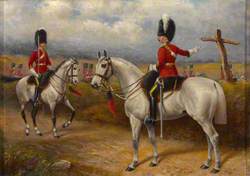How you can use this image
This image is available to be shared and re-used under the terms of the Creative Commons Attribution-NonCommercial-NoDerivatives licence (CC BY-NC-ND).
You can reproduce this image for non-commercial purposes and you are not able to change or modify it in any way.
Wherever you reproduce the image you must attribute the original creators (acknowledge the original artist(s) and the person/organisation that took the photograph of the work) and any other rights holders.
Review our guidance pages which explain how you can reuse images, how to credit an image and how to find more images in the public domain or with a Creative Commons licence available.
DownloadNotes
Add or edit a note on this artwork that only you can see. You can find notes again by going to the ‘Notes’ section of your account.
The name of Baden-Powell became known and respected in two separate spheres of life – as a soldier fighting for his country, and as a worker for peace through the brotherhood of the Scout Movement. Robert Stephenson Smyth Baden-Powell was born in Paddington, London on 22nd February 1857, the sixth son and eighth of ten children of the Reverend H. G. Baden-Powell, a professor at Oxford University. The name Stephenson was taken from one of his Godfathers, George Stephenson, the railway pioneer. Baden-Powell was educated at Charterhouse School, where he first became interested in the arts of scouting and woodcraft. Not an outstanding scholar, he nevertheless gained second place for cavalry in open examination for the Army and was commissioned straight to the 13th Hussars, bypassing the Officer training establishments. He subsequently became their Honorary Colonel for 37 years. His Army career was outstanding from the start.
He published 'Scouting for Boys' in six fortnightly parts at 4d a copy. Sales of these books were tremendous. Soon boys, on their own initiative, began forming themselves into Scout Troops all over the country. Scouting spread quickly through the British Commonwealth and other countries. Baden-Powell, who was then Inspector General of Cavalry, retired from the Army in 1910 at the age of 53 to devote all his enthusiasm to the development of Scouting and its sister Movement, Guiding. In 1912, he married Olave Soames, who was his constant help and companion in all his work. Olave, Lady Baden-Powell, became known throughout the world as World Chief Guide.
At the first International Scout Jamboree at Olympia, London in 1920, Baden-Powell was unanimously acclaimed 'Chief Scout of the World' – a title which has never been held by another Chief Scout. He took the title Lord Baden-Powell of Gilwell – Gilwell Park in Chingford, London, being the Association's Leader Training Centre. Amongst the honours he received were degrees from six Universities, 28 foreign Orders and Decorations, and 19 foreign Scout Awards. In 1938, suffering from ill-health, he went to live in semi-retirement at Nyeri, Kenya. He died in 1941 at the age of 83 and is buried at Nyeri. On the headstone are the words 'Robert Baden-Powell, Chief Scout of the World', surmounted by the Scout and Guide Badges.
Title
Baden-Powell in the Uniform of the South African Constabulary, Standing by His Charger
Date
c.1901
Medium
oil on canvas
Measurements
H 34 x W 30 cm
Accession number
TSA/12a
Work type
Painting
Inscription description
J. Matthews








